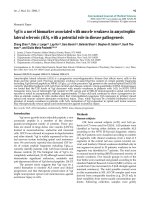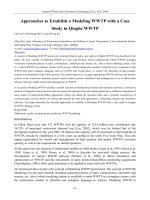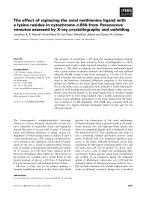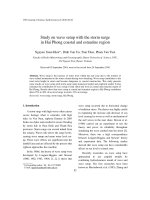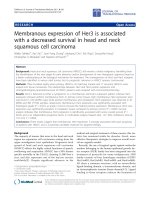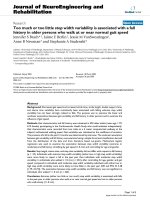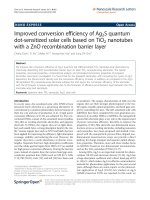Note on inventory models with a permissible delay in payments
Bạn đang xem bản rút gọn của tài liệu. Xem và tải ngay bản đầy đủ của tài liệu tại đây (112.02 KB, 8 trang )
Yugoslav Journal of Operations Research
24 (2014) Number 1, 111-118
DOI: 10.2298/YJOR120622015T
NOTE ON INVENTORY MODELS WITH A
PERMISSIBLE DELAY IN PAYMENTS
Cheng-Tan TUNG
Department of Information Management, Central Police University, Taiwan
Peter Shaohua DENG
Department of Information Management, Central Police University, Taiwan
Jones P. C. CHUANG
Department of Traffic Science, Central Police University, Taiwan
Received: June 2012 / Accepted: April 2013
Abstract: This note tries to provide a patch work for the paper of Chang Dye and
Chuang (published in Yugoslav Journal of Operational Research 2002, number 1, 73-84).
Their paper contains an important finding of smoothly connected property that can very
dramatically simplify the solution procedure of many inventory models with ramp type
demand and trapezoidal type demand. Our improvement will arouse attention of the
researchers and help them apply their important findings in the pending research projects.
Keywords: Fuzzy sets, convex combination.
MSC: 90B05.
1. INTRODUCTION
Hill [1] was the original researcher to develop an inventory model with ramp
type demands, thereafter many papers were done on this topic. For examples, Mandal and
Pal [2] considered inventory system with deterioration items. Wu et al. [3] constructed an
inventory model in which the backlogging rate is relative to the waiting time. Wu and
Ouyang [4] studied inventory systems with two different strategies, starting with stock or
C.T.Tung, P.S.Deng, J.P.C.Chuang / Note on Inventory Models
112
shortage. Wu [5] and Giri et al. [6] developed inventory models with the Weibull
distributed deterioration. Deng [7] revised Wu et al. [3] to provide a complete solution
structure. Manna and Chaudhuri [8] extended inventory models with variable
deteriorating rate. Deng et al. [9] modified Mandal, and Pal [2] and Wu and Ouyang [4]
to find the optimal solution. Skouri et al. [10] extended linear increasing ramp type
demand to arbitrary increasing ramp type demand. Cheng and Wang [11] studied
inventory models with a trapezoidal type demand. Cheng et al. [12] improved Cheng
and Wang [11] from linear increasing and linear decreasing to arbitrary increasing and
arbitrary decreasing trapezoidal type demand. In the above mentioned papers, the
problem was solved by dividing it within different domains of the demand type; so, a
detailed solution process was presented, but their solution structures contained many
different cases, which resulted in very complicated solution method. We have read Chang
et al. [13] and found that it contains an interesting discovery, that is, the smoothly
connected property. We may predict that the smoothly connected property will help
researchers to solve, previously mentioned, complex solution algorithms. However,
Chang et al. [13] contained several questionable results that may set an obstacle for
ordinary readers to understand their paper and then apply the smoothly connected
property in their future research. The purpose of this paper is to provid a patch work for
Chang et al. [13] to aid researchers absorb their important findings.
2. NOTATION AND ASSUMPTIONS
The mathematical model in this paper is developed on the basis of the following
assumptions and notations.
Assumptions
1.
2.
3.
The inventory system involves only one item.
Replenishment occurs instantaneously at an infinite rate.
Let θ ( t ) be the deterioration rate of the on-hand inventory at time t ,
where 0 < < θ ( t ) < 1 and θ ′ ( t ) ≥ 0 .
4.
5.
Shortages are not allowed.
Before the replenishment account has to be settled, the buyer can use sales
revenue to earn interest with an annual rate I e . However, beyond the fixed
credit period, the product still in stock is assumed to be financed with an
annual rate I r , where I r ≥ I e .
Notations
R = annual demand (demand rate being constant)
A = ordering cost per order
I ( t ) = the inventory level at time t
P = unit purchase cost, $/per unit
C.T.Tung, P.S.Deng, J.P.C.Chuang / Note on Inventory Models
113
h = holding cost excluding interest charges, $/unit/year
I e = interest which can be earned, $/year
I r = interest charges which are invested in inventory, $/year, I r ≥ I e
M = permissible delay in settling the account
T = the length of replenishment cycle
C (T ) = the total reverent inventory cost
C1 (T ) = the total reverent inventory cost for T > M in Case 1
C2 (T ) = the total reverent inventory cost for T ≤ M in Case 2
V (T )
= the average total inventory cost per unit time
V1 (T )
= the average total inventory cost per unit time for T > M in Case 1
V2 (T ) = the average total inventory cost per unit time for T ≤ M in Case 2
3. OUR PATCH WORK FOR THEIR DERIVATIONS
We provide some patch work to help ordinary readers to absorb the important
inventory model of Chang at all. They forgot to define g ( x ) . From the text, we can
assume that
x
g ( x ) = ∫ θ ( u )du ,
(1)
0
such that g ′ (T ) = θ (T ) .
They divided the problem into two cases: Case 1: T > M and Case 2: T ≤ M .
For the Case 1, after they derive the total cost, C1 (T ) , as follows
T
T
⎛T g t
⎞
g u
−g t
C1 (T ) = A + hR ∫ e ( ) ∫ e ( ) dudt + PR ⎜⎜ ∫ e ( ) dt − T ⎟⎟
t
0
⎝0
⎠
T
+ PRI r ∫ e
− g (t )
M
T
∫e
t
g (u )
M
(2)
dudt − PRI e ∫ ( M − t ) dt
0
they assume that V1 (T ) is the average total cost per unit time. However, they
did not define V1 (T ) . From the text, we can assume that
V1 (T ) =
C1 (T )
T
.
They found that
(3)
C.T.Tung, P.S.Deng, J.P.C.Chuang / Note on Inventory Models
114
dV1 (T ) − A PR
= 2 + 2
dT
2T
T
T
T
T
⎛
⎞
g (t )
− g (t )
− g (t )
2
g (T )
−
2
e
dt
I
e
⎜⎜ I e M + 2 I r e
r
∫M
∫M
∫t e dudt ⎟⎟
⎝
⎠
T
T
T
⎞ hR ⎛ g T T − g t
⎞
PR ⎛ g T
g t
g u
−g t
+ 2 ⎜⎜ Te ( ) − ∫ e ( ) dt ⎟⎟ + 2 ⎜⎜ Te ( ) ∫ e ( ) dt − ∫ e ( ) ∫ e ( ) dudt ⎟⎟
T ⎝
0
0
0
t
⎠ T ⎝
⎠
(4)
dV1 (T )
contains questionable
dT
results. The corrected version for the second term should be revised as
We must point out that the second term of
T
T
T
⎞
PR ⎛
g t
− g (t )
− g (t )
g (T )
2
I
M
I
T
e
e
dt
I
e
e ( ) dudt ⎟ .
2
2
+
−
⎜
r
r ∫
2 ⎜ e
∫
∫
⎟
2T ⎝
M
M
t
⎠
They tried to show that V1 (T )
(5)
is a convex function so they obtained that
PRI
d 2V1 (T ) 2 A PR
PRI
hR
= 3 + 3 k1 (T ) + 3 k2 (T ) + 3 r − 3 e M 2 ,
2
dT
T
T
T
T
T
(6)
where
T
g t
g T
k1 (T ) = 2∫ e ( ) dt + (Tθ (T ) − 2)T e ( ) ,
(7)
0
T
T
T
0
t
0
T
T
T
M
t
M
−g t
−g t
g u
g T
k2 (T ) = T 2 + 2∫ e ( ) ∫ e ( ) dudt + T (Tθ (T ) − 2 ) e ( ) ∫ e ( ) dt
(8)
and
−g t
−g t
g u
g T
k3 (T ) = T 2 + 2 ∫ e ( ) ∫ e ( ) dudt + T (Tθ (T ) − 2 ) e ( ) ∫ e ( ) dt ,
(9)
where we already use g ′ (T ) = θ (T ) to simplify expressions.
They tried to prove that k j (T ) for j = 1, 2,3 are increasing function by showing
that
dk j (T )
dT
implied that
> 0 for j = 1, 2,3 .
Their proof for
(
)
dk1 (T )
> 0 is right. However, they
dT
T
⎛
⎞ gT
2
dk2 (T )
g T
−g t
= T 2 ⎜ θ (T ) + (θ (T ) ) + θ ′ (T ) e ( ) ∫ e ( ) dt ⎟ e ( ) .
⎜
⎟
dT
0
⎝
⎠
We must point that their result of
revise them as follows
(10)
dk2 (T )
contains questionable result, and then
dT
C.T.Tung, P.S.Deng, J.P.C.Chuang / Note on Inventory Models
(
115
)
(11)
)
(12)
T
⎛
⎞
2
dk2 (T )
−g t
g T
= T 2 ⎜ θ (T ) + (θ (T ) ) + θ ′ (T ) e ( ) ∫ e ( ) dt ⎟ .
⎜
⎟
dT
0
⎝
⎠
On the other hand, they obtained that
(
T
⎛
⎞ gT
2
dk3 (T )
g T
−g t
= T 2 ⎜ θ (T ) + (θ (T ) ) + θ ′ (T ) e ( ) ∫ e ( ) dt ⎟ e ( ) .
⎜
⎟
dT
M
⎝
⎠
We also revise their finding as
(
)
T
⎛
⎞
2
dk3 (T )
−g t
g T
= T 2 ⎜θ (T ) + (θ (T ) ) + θ ′ (T ) e ( ) ∫ e ( ) dt ⎟ .
⎜
⎟
dT
M
⎝
⎠
(13)
They tried to use the Hospital rule to show that lim
T →∞
dV1 (T )
= ∞ , but their
dT
derivation is expressed as
T
⎛
⎞
dV1 (T )
1⎛
g T
g T
−g t
= lim ⎜ PR e ( )θ (T ) + hR ⎜ 1 + e ( ) ∫ e ( ) dt ⎟ θ (T )
⎜
⎟
T →∞
T
→∞
⎜
dT
2⎝
0
⎝
⎠
lim
T
⎞
⎛
⎞
g T
−g t
+ PRI r ⎜ 1 + e ( ) ∫ e ( ) dt ⎟ θ (T ) ⎟ = ∞
⎜
⎟
⎟
M
⎝
⎠
⎠
Their claim of lim
T →∞
(14)
dV1 (T )
= ∞ is right but their result are still questionable, so
dT
we revise them as follows
T
⎛
⎞
dV1 (T )
1⎛
g T
g T
−g t
= lim ⎜ PR e ( )θ (T ) + hR ⎜ 1 + θ (T ) e ( ) ∫ e ( ) dt ⎟
⎜
⎟
T →∞
T →∞ 2 ⎜
dT
0
⎝
⎠
⎝
lim
T
⎛
⎞⎞
g T
−g t
+ PRI r ⎜ 1 + θ (T ) e ( ) ∫ e ( ) dt ⎟ ⎟ = ∞
⎜
⎟⎟
M
⎝
⎠⎠
(15)
We have checked their findings for Case 2, and found that there is no
questionable results in their derivations.
4. DIRECTION FOR THE FUTURE RESEARCH
In their paper, Chang et al. [13] divided the problem into two cases: Case (1)
T > M and Case 2: T ≤ M . Hence, there are two objective functions V1 (T ) for T ≥ M
and V2 (T ) for T ≤ M .
C.T.Tung, P.S.Deng, J.P.C.Chuang / Note on Inventory Models
116
( )
In the literature, researchers found the minimum of V1 (T ) , say V1 T #
( ) where T
T # ≥ M and the minimum of V2 (T ) , say V2 T Δ
Δ
where
≤ M such that the optimal
solution will be
{ ( ) ( )} .
min V1 T # ,V2 T Δ
(16)
They discovered that
V1 ( M ) = V2 ( M ) ,
(17)
and
dV1 (T )
dT
T =M
=
f (M )
M
2
=
dV2 (T )
dT
T =M
(18)
where
⎛ gM M gt ⎞ 1
f ( M ) = − A + PR ⎜ Me ( ) − ∫ e ( ) dt ⎟ + PRI e M 2
⎜
⎟ 2
0
⎝
⎠
M
M
M
⎛ gM
⎞
−g t
−g t
g u
+ hR ⎜⎜ Me ( ) ∫ e ( ) dt − ∫ e ( ) ∫ e ( ) dudt ⎟⎟
0
0
t
⎝
⎠
(19)
Hence, using the convexity property of V1 (T ) and V2 (T ) , V1 (T ) and V2 (T ) can
not both have interior minimum, such that depending on the sign of f ( M ) , they found
( )
the optimal solution, say V T * , that
( )
V T*
( )
( )
( )
⎧V T * ,
⎪ 1
⎪
= ⎨V2 T * ,
⎪
⎪⎩ V1 T * = V2 T * ,
( )
f ( M ) < 0,
f ( M ) > 0,
(20)
f ( M ) = 0.
We must improve their expression as follows
( )
V T*
( )
( )
⎧ V1 T # ,
⎪
⎪
= ⎨V2 T Δ ,
⎪
⎪⎩V1 ( M ) = V2 ( M ) ,
f ( M ) < 0,
f ( M ) > 0,
(21)
f ( M ) = 0.
We can predict that this kind of approach in showing that the interior optimal
solution only happens inside one interval will be very useful when dealing with some
inventory models with multiple demand patterns. For examples, inventory models with
ramp type demand, Hill [1], Wu et al. [3], Wu and Ouyang [4], Wu [5], Giri et al. [6],
C.T.Tung, P.S.Deng, J.P.C.Chuang / Note on Inventory Models
117
Deng [7], Manna and Chaudhuri [8], Deng et al. [9], and Skouri et al. [10], and inventory
models with trapezoidal type demand, Cheng and Wang [11], and Cheng et al. [12].
5. CONCLUSION
In Chang et al. [13], the authors abstractly treated the deterioration as a nondecreasing function, which allows their model to be applied in many possible practical
applications. For examples, they provided two special cases: linear deterioration and twoparameter Weibull distribution. However, in their paper, there are several questionable
results that may hamper ordinary readers to comprehend their important findings of
smoothly connected properties. Hence, in this note, we provide a patch work to help
practitioners to absorb their achievement and then apply their findings to future research
works.
REFERENCES
[1]
[2]
[3]
[4]
[5]
[6]
[7]
[8]
[9]
[10]
[11]
[12]
Hill, R.M., “Inventory model for increasing demand followed by level demand”, Journal of
the Operational Research Society, 46 (1995) 1250-1259.
Mandal, B., and Pal, A.K., “Order level inventory system with ramp type demand rate for
deteriorating items”, Journal of Interdisciplinary Mathematics, 1 (1998) 49-66.
Wu, J.W., Lin, C., Tan, B., and Lee, W.C., “An EOQ model with ramp type demand rate for
items with Weibull deterioration”, International Journal of Information and Management
Sciences, 10 (1999) 41-51.
Wu, K.S., and Ouyang, L.Y., “A replenishment policy for deteriorating items with ramp type
demand rate”, Proceeding of National Science Council ROC (A), 24 (2000) 279-286.
Wu, K.S., “An EOQ inventory model for items with Weibull distribution deterioration, ramp
type demand rate and partial backlogging”, Production Planning & Control, 12 (2001) 787793.
Giri, B.C., Jalan, A.K., and Chaudhuri, K.S., “Economic order quantity model with Weibull
deterioration distribution, shortage and ramp-type demand”, International Journal of Systems
Science, 34 (2003) 237-243.
Deng, P.S., “Improved inventory models with ramp type demand and Weibull deterioration”,
International Journal of Information and Management Sciences, 16 (2005) 79-86.
Manna, S.K., and Chaudhuri, K.S. “An EOQ model with ramp type demand rate, time
dependent deterioration rate, unit production cost and shortages”, European Journal of
Operational Research, 171 (2006) 557-566.
Deng, P.S., Lin, R., and Chu, P., “A note on the inventory models for deteriorating items with
ramp type demand rate”, European Journal of Operational Research, 178 (2007) 112-120.
Skouri, K., Konstantaras, I., Papachristos, S., and Ganas, I., “Inventory models with ramp type
demand rate, partial backlogging and Weibull deterioration rate”, European Journal of
Operational Research, 192 (2009) 79-92.
Cheng, M., and Wang, G., “A note on the inventory model for deteriorating items with
trapezoidal type demand rate”, Computers & Industrial Engineering, 56 (2009) 1296-1300.
Cheng, M., Zhang, B., and Wang, G., “Optimal policy for deteriorating items with trapezoidal
type demand and partial backlogging”, Applied Mathematical Modelling, 35 (2011) 35523560.
118
C.T.Tung, P.S.Deng, J.P.C.Chuang / Note on Inventory Models
[13] Chang, H.J., Dye, C.Y., and Chuang, B.R., “An inventory model for deteriorating items under
the condition of permissible delay in payments”, Yugoslav Journal of Operations Research, 12
(1) (2002) 73-84.
